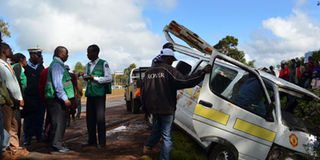St John Ambulance launches rescue centres to reduce road accident fatalities

A St John Ambulance rescue team at an accident scene. The organisation has set up rescue centres across the country's main black spots to help reduce road accidents. PHOTO | COURTESY
What you need to know:
- More than 3,000 people have died this year in road accidents
- The transport ministry says there are over 28 locations on the main highways where road accidents are most likely to occur
The number of Kenyans dying in road accidents may soon drop following the launch of highway rescue centres at a number of black spots in the country.
“There are over 15 rescue centres in the country, with each having an average of 28 personnel who are trained to respond,” said Fred Majiwa, the Communications Manager at St John Ambulance Kenya.
According to the organisation, about 57 percent of victims of road accidents die as a result of mishandling at the scene.
More than 3,000 people have died this year in road accidents, putting in question the commitment of the police in curbing the trend. (READ: Traffic boss fights case to save his job)
In the last two weeks, over 30 people have been killed on roads in various parts of the country, a move that has prompted authorities to rethink accident response.
PIVOTAL ROLE
The highway rescue centres continue to play a pivotal role in saving lives as has been witnessed at the infamous Kyumbi-Machakos junction. “We used to hear of all accident victims having perished. Today, after the launch of our rescue centre, we only hear of six dead, eight hospitalised. This shows the gap is fast reducing,” Mr Majiwa said.
He cited the December 3, 2002 incident in which retired President Mwai Kibaki was injured in a road accident while on his way back to Nairobi from a campaign meeting at Machakos junction, some 40 kilometres from Nairobi.
“The highway rescue team was the first to arrive at the scene,” he said, adding: “After the Sachangwan accident in 2009, we have moved in to also train people on emergency fire fighting.”
To date, Mr Majiwa says more than 883 lives have been saved through the support of the highway rescue centres. “We may not have reached our optimal level, but our key target is to see that 57 per cent case is cut to less than 30 per cent. This is realistic if we cover all the black spots in Kenya.
“This, however, requires a lot of resources. We therefore only expand when our resource basket deepens,” he said.
The transport ministry says there are over 28 locations on the main highways where road accidents are most likely to occur. (READ: Matatus my ‘worst pain’, says minister)
The black spots on the Nairobi-Eldoret highway, Mombasa Road, Thika Superhighway, the Kericho-Kisumu stretch and Embu-Meru Road account for more than 60 per cent of all accidents occurring in the country. (READ: Agency leads fight against bad drivers ahead of festivities)
ORGANISATION ELEVATED
Meanwhile, St Johns Ambulance Kenya has been elevated to an autonomous operation, a move that has given the charitable body more responsibilities in the handling of rescue and emergency cases in the country.
“We have grown in numbers to over 21,000 volunteers, making us among the top establishments in the world. Our humanitarian activities have also increased rapidly,” said Mr Majiwa.
The restructuring has seen St Johns Ambulance Kenya classified as a Priory, meaning it will have a free hand on its operations, as opposed to Association, where it would routinely consult the United Kingdom office before making some critical decisions.
Its name has also changed to St Johns Priory of Kenya while its head would no longer be a chairman but a Prior.





